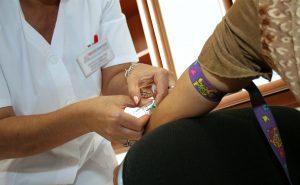In the past it would have been a dream to do lung cancer screening with a simple blood test. Now it is a reality. Dr. Gerard Silvestri from the Medical University of South Carolina in Charleston has developed such a screening test. He used two biomarkers for lung cancer, proteins LG3BP and C163A that are very specific for lung cancer. These proteins leak from the tumor into the blood, and by taking a simple blood sample, measuring these proteins has become possible.
Physicians in the US detect almost 1.6 million nodules every year in people’s lungs. In the past bronchoscopies were necessary, along with a biopsy of the lung nodule. A pathologist had to determine whether the nodule was benign or cancerous.
Dr. Silvestri’s clinical trial
Dr. Silvestri and his research team have just completed a clinical trial. First of all, they found that it was 97% reliable in determining whether a nodule was benign or cancerous. Here is the research paper. In this clinical trial 685 patients presented with newly diagnosed single nodules in the lung. All the patients were 40 years or older. CT scan findings described the size of the nodules and the location within the lungs. Furthermore, bronchoscopy was the next step on those nodules that were close to a bronchus tube. In addition, transthoracic biopsies were necessary, if the nodule was growing in the lung tissue. 16% of the nodules were malignant (ie. lung cancer). Of these 59% were adenocarcinomas. All patients had a history of smoking.
False negative nodules (with negative blood test)
As a result Dr. Silvestri concluded that using this new blood test one could exclude the vast majority of cases who have benign nodules. Even, if a nodule received a false diagnosis being harmless, the follow-up CT scans would finally show growth in the case of cancer. At this point a biopsy would show the true diagnosis and a surgeon would remove the nodule.
Screening recommendation
A low-risk tumor,” Dr. Silvestri said, “will be followed with serial imaging. After 2 years of periodical, computed tomography scans and without evidence of growth, we can say it’s benign.”
Dr. Silvestri noted that incorporating the blood screening method into the work-up of lung nodules is an advantage. It results in 40% less invasive procedures on patients. This method is combined with the traditional ways of treating patients with lung nodules. But the more invasive procedures are only applied when absolutely necessary, like in the case of the malignant lung cancers. Patients with benign lung lesions will not have to undergo the more invasive procedures.
Dr. Silvestri and colleagues said: “the next step from here should be to conduct a clinical utility study to assess how clinical decision-making and use of invasive procedures are altered with knowledge of the results of the recently studied test.”
Conclusion
A clinical trial showed that there is a good correlation between malignant (cancerous) lung nodules and a positive screening test. This involved two biomarkers for lung cancer, proteins LG3BP and C163A. When this test is positive, there is a high probability (97%) that there is an underlying lung cancer present. When negative, the probability is high that the lung nodule is harmless. This knowledge helps in the decision making process. In the case of early cancer, surgery would be the next step. In the case of a benign nodule, observation would be the next step. The authors have suggested a prospective clinical trial where this method of lung cancer detection will undergo further testing.







